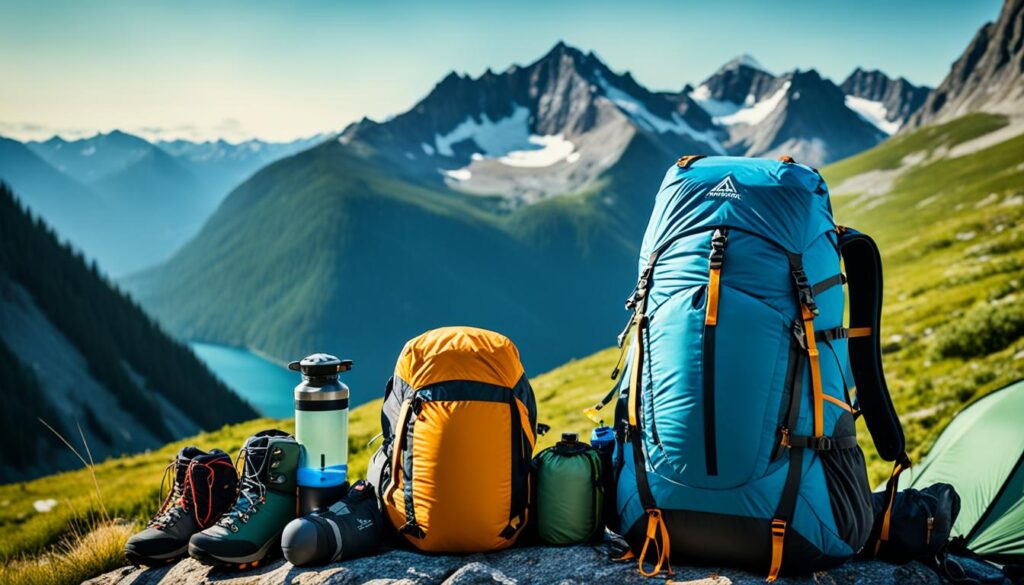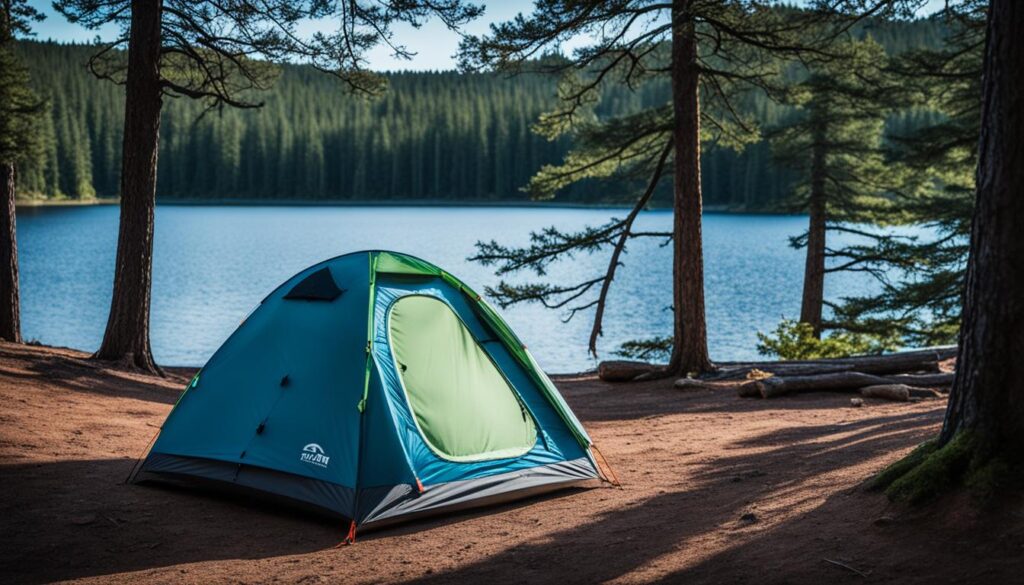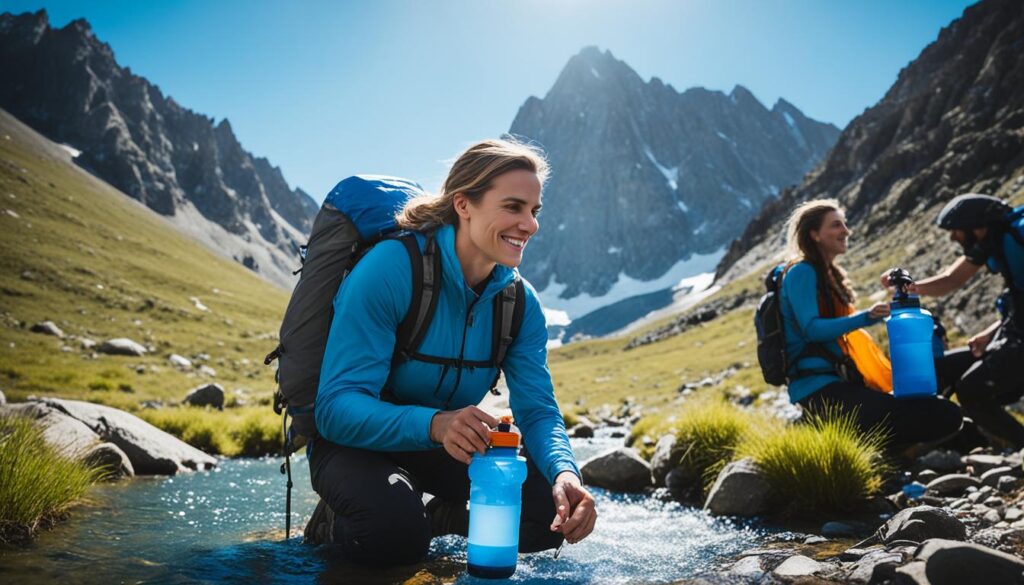Backpacking Gear Guide: Essentials for Every Adventure

A backpacking trip can be the experience of a lifetime, but it’s important to have the right gear. This comprehensive guide will cover all the essential backpacking gear you need for every adventure. From backpacks and tents to sleep systems and cooking gear, we’ve got you covered. Get ready to embark on your backpacking travel journey fully prepared!
Key Takeaways:
- Backpacking travel offers incredible experiences, but having the right gear is crucial.
- Essential backpacking gear includes backpacks, tents, sleep systems, water filtration, stoves, and more.
- Choosing the right gear depends on factors like trip duration, climate, and personal preferences.
- Proper meal planning, dressing in layers, and prioritizing safety are key for successful backpacking adventures.
- Investing in quality gear ensures durability, comfort, and overall enjoyment during backpacking trips.
Backpack
When it comes to backpacking, choosing the right backpack is crucial for a comfortable and successful trip. The size and features of your backpack can greatly impact your overall experience. Whether you’re embarking on a three-season adventure or a shorter trip, finding the perfect backpacking pack is essential.
For most three-season backpacking trips, a backpack between 50 and 80 liters is recommended. This size range provides ample space to carry all your essential gear without being overly bulky. Smaller packs can be suitable for shorter trips or ultralight backpacking kits, where minimizing weight is a top priority.
When selecting a backpack, consider factors such as carrying capacity, compartments, pockets, materials, and the overall fit. It’s important to have enough room for your gear while ensuring your backpack feels comfortable on your back. Adjustable straps and a well-padded hip belt can contribute to a better fit and weight distribution.
Here are some key points to keep in mind when choosing a backpack for backpacking:
- Size: Opt for a backpack between 50 and 80 liters for three-season trips.
- Features: Consider the carrying capacity, compartments, pockets, and materials of the backpack.
- Fit: Ensure the backpack fits comfortably on your back and has adjustable straps and a padded hip belt.
Remember, your backpack will be your trusted companion throughout your entire backpacking journey. Take the time to find a backpack that suits your needs and preferences, and you’ll be ready to hit the trails with confidence!
Shelter
A shelter is an essential component of any backpacking trip as it provides protection from the elements, ensuring a comfortable and secure outdoor experience. There are various options available when it comes to selecting a shelter for your backpacking adventure.
Tents: Livable Space and Protection
Tents are the go-to choice for most backpackers, especially beginners. They offer a combination of livable space and protection from the elements. Modern backpacking tents are lightweight, easy to set up, and designed to withstand various weather conditions.

Hammocks: Comfortable in Warmer Weather
Hammocks can be a comfortable alternative to tents, especially in warm weather. They provide a unique sleeping experience and are lightweight to carry. However, hammocks require extra setup and additional equipment such as straps and bug nets. They may not be suitable for all environments or seasons.
Tarps: Lightweight, but Lacking Bug Protection
Tarps are a lightweight shelter option for experienced backpackers seeking an ultralight setup. They provide basic protection from rain and wind but lack bug protection. Tarps are versatile and can be set up in various configurations, offering flexibility in different landscapes and weather conditions.
Before heading out, ensure you have all the necessary accessories for your chosen shelter option. This may include poles, stakes, guylines, and repair kits to handle any unexpected situations.
| Shelter Type | Pros | Cons |
|---|---|---|
| Tents | Provides livable space Offers protection from the elements Easy to set up |
Generally heavier compared to other options Bulky to carry |
| Hammocks | Comfortable sleeping experience Lightweight Great for warm weather |
Extra setup required May not be suitable for all environments |
| Tarps | Ultralight option Offers versatility in setup configurations |
Lacks bug protection Requires experience to set up properly |
Sleep System
A proper sleep system is essential for a good night’s sleep on backpacking trips. When it comes to choosing a sleep system, you’ll need to consider key components such as sleeping bags and sleeping pads. Let’s dive into each of these elements to help you make the best choices for your backpacking sleep system.
Sleeping Bags
When selecting a sleeping bag, one of the most crucial factors to consider is the comfort rating. This rating indicates the lowest temperature at which the bag will keep you warm without additional layers. Consider the destination’s temperature and choose a sleeping bag with a comfort rating suitable for those conditions.
Weight, warmth, and packability are also important factors to keep in mind. Lightweight sleeping bags are ideal for backpacking, as they won’t weigh you down. Look for insulation materials that offer an optimal warmth-to-weight ratio, such as synthetic or down insulation. Additionally, consider how easily the sleeping bag can be compressed and packed into your backpack.
Sleeping Pads
Pairing your sleeping bag with a high-quality sleeping pad is crucial for comfort and insulation. Sleeping pads provide a layer of cushioning and insulation between your body and the ground, ensuring a more restful sleep.
When choosing a sleeping pad, consider factors such as weight, thickness, and insulation. Inflatable sleeping pads are lightweight and can be easily packed, while foam pads offer durability and insulation. Look for pads with an R-value suitable for the expected temperature range of your backpacking trip. The higher the R-value, the better the insulation.
| Sleeping Bags | Sleeping Pads |
|---|---|
| Provides warmth and comfort | Offers cushioning and insulation |
| Consider comfort rating, weight, warmth, and packability | Consider weight, thickness, and insulation (R-value) |
| Choose suitable insulation material (synthetic or down) | Choose between inflatable or foam pads |
Incorporating a high-quality sleep system into your backpacking gear setup ensures that you’ll be well-rested and ready to tackle each day’s adventures. Choose a sleeping bag and sleeping pad that cater to your specific needs and preferences. With the right sleep system, you’ll have a comfortable and rejuvenating experience on your backpacking journey.
Water Storage and Filtration
Access to clean drinking water is crucial during backpacking trips. When venturing into the backcountry, it’s essential to bring along adequate water storage containers and a reliable filtration system to ensure a safe and hydrated journey.
Water Storage
Carrying suitable water containers is the first step in securing your water supply. Opt for durable and lightweight bottles that can withstand the rigors of backpacking. Consider the size and capacity based on the duration of your trip and the availability of water sources along your route.
For longer backpacking trips, a hydration reservoir with a high-capacity bladder is a convenient option. These bladders can be placed inside your backpack, allowing easy access to water while on the move. Make sure to choose a reservoir made from BPA-free materials to ensure clean and safe drinking water.
Here are some popular water storage options:
- Reusable water bottles
- Hydration reservoirs
- Collapsible water containers
Water Filtration
While natural water sources are abundant in the backcountry, they may contain harmful contaminants and pathogens. To ensure safe drinking water, a reliable filtration system is essential.
When choosing a backpacking water filter, consider the filtration method, filter lifespan, and ease of use. Some popular filtration methods include:
- Gravity filters: These systems rely on the force of gravity to pull water through the filter, removing contaminants along the way.
- Pump filters: These filters require manual pumping to push water through the filter cartridge, providing instant access to clean drinking water.
- Straw filters: Lightweight and portable, straw filters allow you to drink directly from the water source, filtering out impurities as you sip.
It’s also wise to carry backup purification methods, such as water purification tablets or a secondary water filter. These options come in handy if your primary filtration system malfunctions or if you encounter water sources that are difficult to filter.
Remember: Follow the manufacturer’s instructions for proper use and maintenance of your water filtration system to ensure optimal performance and longevity.
Pro Tip: Before your trip, research water sources along your planned route and note any potential risks or recommendations regarding water quality.
By investing in a reliable water storage and filtration system, you can stay hydrated and healthy throughout your backpacking adventure, even when encountering remote or unreliable water sources. Prioritize clean drinking water to enhance your overall comfort and safety in the wilderness.

| Water Storage Containers | Pros | Cons |
|---|---|---|
| Reusable water bottles | – Lightweight and portable – Easy to refill – Wide variety of options available |
– Limited capacity – May not be suitable for extended trips – Potential for leakage or breaks |
| Hydration reservoirs | – High-capacity bladder – Hands-free drinking with a tube – Fits inside backpacks |
– Requires cleaning and maintenance – May be more expensive – Difficult to gauge water levels |
| Collapsible water containers | – Lightweight and packable – Large capacity options available – Versatile for different water sources |
– Prone to punctures or leaks – Requires careful handling and storage – Limited durability |
Note: Each type of water storage container has its advantages and disadvantages. Consider your specific needs and preferences when choosing the most suitable option for your backpacking journey.
Stove and Cookware
A lightweight and efficient stove is essential for a successful backpacking trip. When it comes to backpacking stoves, there are various options to consider based on your cooking needs and fuel preferences. Canister stoves are popular among backpackers due to their ease of use and portability. These stoves use pre-pressurized gas canisters, making them convenient for quick and simple cooking.
However, if you’re planning to go on a backpacking adventure in cold temperatures, a liquid fuel stove might be more suitable. Liquid fuel stoves, such as white gas stoves, offer better performance and efficiency in low temperatures. They can also burn different types of liquid fuels, providing flexibility during long trips where canisters may not be readily available.
When choosing a stove, consider factors such as weight, fuel availability, cooking speed, and overall durability. It’s also important to think about the type of cookware you’ll be using. Lightweight backpacking cookware sets are designed to be compact and efficient, allowing for easy storage in your backpack.
Here’s an overview of popular backpacking stoves and their features:
| Stove Type | Pros | Cons |
|---|---|---|
| Canister Stoves | Easy to use; lightweight; compact; quick cooking times | Reliant on canister availability; canisters can be hard to recycle |
| Liquid Fuel Stoves | Works well in cold temperatures; fuel versatility; long-lasting | Requires priming; can be heavier; more complex maintenance |
| Wood Stoves | Fuel source readily available; eco-friendly; lightweight | Slower cooking time; limited in fire-restricted areas |
Along with your stove, be sure to pack lightweight and durable cookware, such as pots, pans, and utensils, suitable for camp cooking. Additionally, don’t forget to bring cleaning supplies, such as biodegradable soap and a sponge, to maintain hygiene and prevent food contamination.
With the right stove and cookware, you’ll be able to prepare delicious and nourishing meals during your backpacking adventure.
Food and Snacks
Planning your meals and snacks is crucial for a successful backpacking trip. When out on the trail, it’s important to fuel your body with nourishing foods that provide the energy needed to keep going. Whether you’re embarking on a day hike or a multi-day trek, having the right backpacking food and trail snacks is essential for maintaining energy levels and staying satisfied.
Meal Planning
Meal planning is a key aspect of preparing for a backpacking trip. Before heading out, take some time to plan each meal and consider the nutritional content of the foods you choose. Opt for lightweight, non-perishable options that are easy to pack and require minimal preparation. Calorie-dense foods that provide a good balance of carbohydrates, protein, and healthy fats are ideal for sustained energy on the trail.
Here are some meal planning tips to consider:
- Choose dehydrated meals or ready-to-eat options that can be easily rehydrated with water.
- Pack single-serving packets of sauces, spices, and condiments to add flavor to your meals.
- Include a variety of foods to keep your taste buds satisfied and to ensure you’re getting a good mix of nutrients.
- Consider any dietary restrictions or food allergies when planning your meals.
Trail Snacks
In addition to meals, having a selection of trail snacks is essential for maintaining energy levels between meals and during long hikes. Trail snacks should be lightweight, easy to eat, and provide a quick source of energy. Here are some examples of trail snacks to consider:
- Granola bars or protein bars
- Trail mix with nuts, dried fruits, and chocolate
- Beef jerky or other dried meats
- Energy gels or chews
- Crackers or rice cakes
- Instant oatmeal or breakfast bars
It’s important to pack more snacks than you think you’ll need, as unexpected circumstances can arise, and having extra fuel can make a big difference. Keep your snacks easily accessible in a side pocket of your backpack or in a hip belt pocket for quick and convenient access on the trail.
| Meal | Main Course | Side Dish | Snack |
|---|---|---|---|
| Breakfast | Instant oatmeal | Granola bar | Trail mix |
| Lunch | Wrap with canned tuna | Crackers | Dried fruit |
| Dinner | Dehydrated pasta with sauce | Instant mashed potatoes | Beef jerky |
| Snack | Nut butter and pretzels | Fruit cups | Protein bar |
Remember, packing the right backpacking food and trail snacks can make a significant difference in your overall experience on the trail. By planning ahead and choosing nutritious, lightweight options, you’ll have the fuel you need to tackle any adventure with energy and enthusiasm.
Apparel
When it comes to backpacking, choosing the right clothing is vital for your comfort and safety on the trail. Dressing in layers allows you to regulate your body temperature as you hike through varying conditions. Here’s a breakdown of the essential apparel items to consider for your backpacking adventure:
Moisture-Wicking Base Layer
A moisture-wicking base layer is the foundation of your clothing system. These lightweight and breathable garments help to keep sweat away from your skin, keeping you dry and comfortable. Look for base layer tops and bottoms made from synthetic materials like polyester or merino wool that offer excellent moisture-wicking properties.
Insulation Layers
Layering up with insulating garments helps to trap heat close to your body, keeping you warm in cold environments. Consider packing pieces like fleece jackets, down or synthetic insulation jackets, and thermal pants for extra warmth. These layers should be easily removable and adjustable to accommodate temperature fluctuations throughout the day.
Waterproof and Wind-Resistant Outer Layer
Protecting yourself from the elements is crucial, especially if you encounter rain, wind, or snow during your backpacking trip. Invest in a high-quality waterproof and wind-resistant jacket and pants that will keep you dry and shielded from strong gusts. Look for garments that are both breathable and durable, allowing moisture to escape while preventing water from seeping in.
Hiking Boots or Shoes
Your choice of footwear can make or break your backpacking experience. Opt for comfortable and supportive hiking boots or shoes that are suitable for the terrain you’ll be traversing. Consider factors like ankle support, traction, and waterproofing when selecting your footwear. Be sure to break them in before hitting the trail to avoid any discomfort or blisters.
Essential Accessories
Don’t overlook the importance of accessories that provide additional protection from the sun and bugs. Wear a wide-brimmed hat to shield your face and neck from harmful UV rays. Invest in a pair of sunglasses that offer adequate UV protection and reduce glare. Pack lightweight and breathable gloves to keep your hands warm and protected during chilly mornings or high-altitude hikes. Additionally, consider wearing gaiters to prevent debris, moisture, and insects from entering your boots.
Remember, selecting the right apparel can significantly enhance your backpacking experience, ensuring you stay comfortable, dry, and protected from the elements.
| Item | Description |
|---|---|
| Moisture-Wicking Base Layer | Lightweight and breathable garments to keep you dry and comfortable. |
| Insulation Layers | Fleece jackets, down/synthetic insulation jackets, and thermal pants for extra warmth. |
| Waterproof and Wind-Resistant Outer Layer | Jacket and pants to protect you from rain, wind, and snow. |
| Hiking Boots or Shoes | Comfortable and supportive footwear suitable for the terrain. |
| Essential Accessories | Wide-brimmed hat, sunglasses, gloves, and gaiters for sun and bug protection. |
Conclusion
Embarking on a backpacking travel adventure is an exciting and fulfilling experience. To ensure a successful trip, it is essential to have the right gear. This comprehensive guide has covered the essentials of backpacking gear, providing you with the knowledge to make informed choices.
When preparing for your backpacking trip, remember to prioritize safety by investing in navigation tools and a comprehensive first aid kit. Proper meal planning and dressing in layers are also crucial to ensure comfort and sustenance throughout your journey.
With the right backpack, shelter, sleep system, cooking gear, and essential accessories, you’ll be fully equipped to take on any trail and embrace the beauty of the great outdoors. So pack your bags, lace up your boots, and get ready to create unforgettable memories on your backpacking travel adventure!